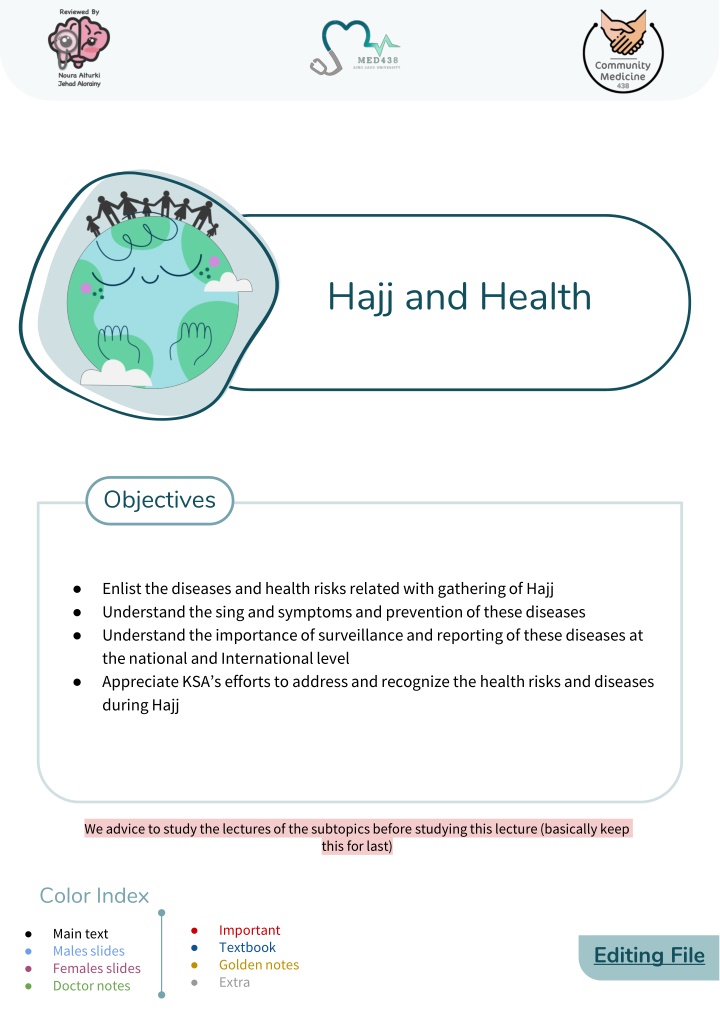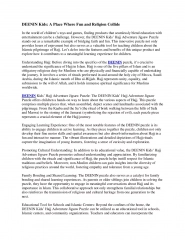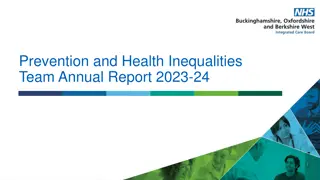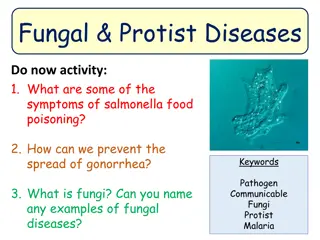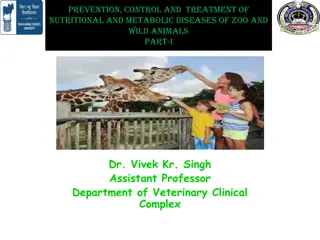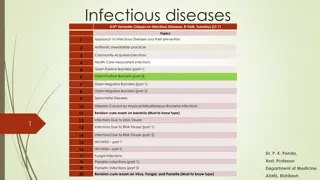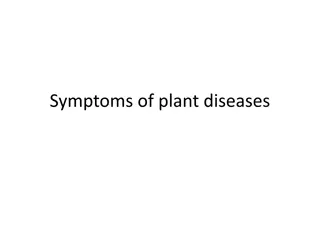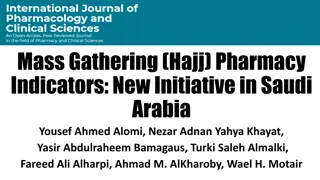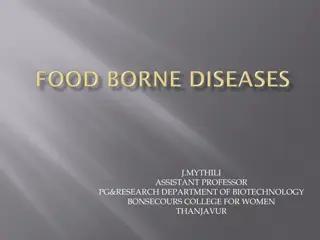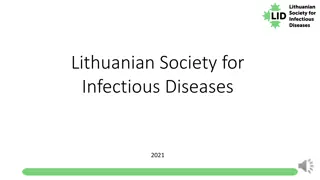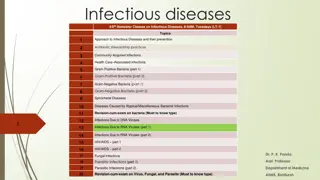Hajj and Health Risks: Diseases, Symptoms, and Prevention
The annual Hajj pilgrimage poses various health risks related to communicable and non-communicable diseases. Learn about the diseases, symptoms, prevention strategies, and the importance of surveillance. Explore KSA's efforts in addressing health risks during Hajj.
Download Presentation

Please find below an Image/Link to download the presentation.
The content on the website is provided AS IS for your information and personal use only. It may not be sold, licensed, or shared on other websites without obtaining consent from the author.If you encounter any issues during the download, it is possible that the publisher has removed the file from their server.
You are allowed to download the files provided on this website for personal or commercial use, subject to the condition that they are used lawfully. All files are the property of their respective owners.
The content on the website is provided AS IS for your information and personal use only. It may not be sold, licensed, or shared on other websites without obtaining consent from the author.
E N D
Presentation Transcript
Hajj and Health Objectives Enlist the diseases and health risks related with gathering of Hajj Understand the sing and symptoms and prevention of these diseases Understand the importance of surveillance and reporting of these diseases at the national and International level Appreciate KSA s efforts to address and recognize the health risks and diseases during Hajj We advice to study the lectures of the subtopics before studying this lecture (basically keep this for last) Color Index Important Textbook Golden notes Extra Main text Males slides Females slides Doctor notes Editing File
Introduction The Hajj pilgrimage is one of the greatest mass gatherings in the world, and presents unique public health challenges. Mass gatherings can present important public health challenges related to thehealth of attendees and of the host country populationand health services. Millions of Muslims from around the world gather annually to perform the Hajj pilgrimage in Mecca, in Saudi Arabia. Pilgrims performing the Hajj are predisposed to diverse and significant health risks, due to: The limited time and confined geographical area of the event. The large numbers of people, with population densities among the millions of participants, reaching 7 persons/m2. Health risks and hazards associated with mass gatherings Transmission of communicable diseases, including antibiotic-resistant bacterial infections. Water and sanitation related disorders. Non-communicable diseases and exacerbation of comorbidities (eg, diabetes, hypertension, COPD, and cardiovascular events). Mental health and psychosocial disorders. Thermal disorders, including heat hyperpyrexia, heat stroke, heat exhaustion, and dehydration. Stampedes. Accidents, trauma, and crush injuries. Terrorist incidents (biological and chemical warfare threats, explosives, and bombs). Diseases and Health Risks During Hajj Non-Communicable diseases Communicable diseases
Communicable diseases Unhygienic practices and close contacts between pilgrims in overcrowded situations during the Hajj rituals, as well as international travel, increase the risks of outbreaks and the spread of infectious diseases among pilgrims. The risk of infectious diseases transmission may extend to the local Saudi population and to the home population of returning pilgrims after Hajj. This could strain the public health services in Saudi Arabia and may threaten global health security. Meningococcal disease Meningitis, or inflammation of the meninges, can be caused by several different bacterial pathogens. By far, the most important of these pathogens is Neisseria meningitidisbecause of its potential to cause epidemics. Epidemiology Crowded conditionsare a risk factor for the carriage and transmission of Neisseria meningitidis. Hajj has been associated with outbreaks of invasive meningococcal disease. Most cause of epidemics Outbreaks have high fatality rates. Associated with medical costs. Preventive measures are needed to control its transmission. During the 2000 and 2001 Hajj pilgrimages, Saudi Arabia experienced 2 large outbreaks of invasive meningococcal disease that led to global spread of N. meningitidis serogroup W-135 This happened during hajj before that this strain wasn t known. Neisseria meningitidis Bean shaped, Gram negative, aerobic diplococci. Outer membrane of lipids, membrane proteins and lipopolysaccharides. Pathogenic meningococci are enveloped by a polysaccharide capsule the capsule identifies the valurince Serogroups A, B and C account for most cases A & C in Asia and Africa, while B & C in Europe and the Americas. Humans are the only reservoir. Nasopharynx is the natural habitat and reservoir, in most cases colonization of Nasopharynx is asymptomatic. However, blood stream invasion by N. meningitidis can lead to meningitis and septicaemia with serious consequences. Even with adequate chemotherapy, meningococcal meningitis has a fatality rate of about 10% and about 15% of the survivors have residual (CNS) damage hearing loss, vision loss, and preeminent damage
Meningococcal disease Host Maternal antibodies offer protection against invasive disease till the age of six months. Susceptibility peaks at age 6 -12 months and decreases again after colonization of closely related non-pathogenic bacteria. Invasive disease occurs if no protective bactericidal antibodies are mounted against the infecting strain. Those infected with the HIV are probably also at increased risk for sporadic meningococcal disease due to low immunity Environment Individuals acquire the infection if they are exposed to virulent bacteria and have no protective antibodies. Crowded living conditionsalso facilitate disease spread, since individuals from different areas have different strains of meningococci. The risk of invasive disease is higher in the first few days after exposure to a new strain. Smokers Mode of Transmission Direct contact. Respiratory droplets: coughing and sneezing can be transmitted to non immune hosts within a distance of one meter. The average incubation period is 3 -4 days with a range of 2 to 10 days, this is also the period of communicability. The bacteria are rapidly eliminated from the nasopharynx after starting antibiotics, usually within 24 hours. Both cases and carriers serve as the source of infection. Diagnosis The diagnosis of meningococcal meningitis is suspected by the clinical presentation and a lumbar puncture showing a purulent spinal fluid. Typical CSF abnormalities in meningitis include: Increased pressure (>180 mm water) WBC counts between 10 and 10,000 cells/ L, (predominantly neutrophils) Decreased glucose concentration (<45 mg/dL) Increased protein concentration (>45 mg/dL)
Meningococcal disease Clinical Features Most Common symptoms In infants and young children -Acute onset of intense headache -High fever can reach to 40 -Nausea & Vomiting -Sensitivity to light (photophobia) -Stiff neck. -Can develop over several hours, or 1 -2 days. -Meningococcal septicaemia: which is characterized by a haemorrhagic rash which usually indicates disease progression and rapid circulatory collapse -Subacute infection that progresses over several days. -There is a slower onset of signs and symptoms -Nonspecific symptoms and neck stiffness may be absent. -Irritability and projectile vomitingmay be the presenting features in this age group. -Seizuresoccur in 40% of children with meningitis. -Neck stiffness can be absent in children so a high fever in children meningitis unless proven otherwise Management It is potentially fatal and should always be viewed as medical emergency. It requires early recognitionof the disease, prompt initial parenteral antibiotictherapy and close monitoring. Admission to a hospital centre is essential. Several antibiotics can be used for treatment including penicillin, ampicillin, chloramphenicol and ceftriaxone. Preventive measures for Meningococcal disease Health awareness and educational campaigns Efficient disease surveillance and response systems Chemoprophylaxis Use of vaccination 1-Chemoprophylaxis: Is the preferred means of prevention of disease among close contacts of sporadic cases. Antibiotics that can be used for chemoprophylaxis are: Ciprofloxacin( single oral dose of 500 mg), rifampicin (600 mg 12 hourly for 2 days), or ceftriaxone (250 mg IM single), minocycline, ofloxacin, and spiramycin. - Rifampicin 10 mg/Kg 12 hourly for 2 days (5mg/Kg for infants). - Injection ceftriaxone 125 mg IM single dose. Rifampicin is not given to pregnant women
Meningococcal disease 2-Meningococcal Vaccines: More than 90% of meningococcal disease, vaccines are available for group A, C, Y and W - 135 At present two types of meningococcal vaccines are licensed; Meningococcal polysaccharide vaccines: Bivalent protection against serogroups A and C. Quadrivalent protection against serogroups A, C, Y and W -135 commonly used The dose for primary vaccination for both adults and children older than 2 years is a single 0.5 ml SC injection. Protective levels of antibody are usually achieved within 7 -10 days of vaccination Meningococcal conjugated polysaccharide vaccine. Recommendations for use of meningococcal vaccine: Vaccination with a single dose of polysaccharide vaccine is recommended for travelers above 18 months of age going to an area experiencing an epidemic of meningococcal disease or to areas with a high rate of endemic meningococcal disease.
Respiratory tract infection Respiratory diseases are the most common cause of outpatient department visits during the Hajj, accounting for 41 60.8% of visits Upper respiratory tract infections (URTIs), including pharyngitis, viral URTI,and tonsillitis Comorbidity is one of the risk factors for development of URTI. In pilgrims who suffered from comorbidity, there was a significant association with longer duration of cough, longer duration of sore throat, and severe influenza-like illness requiring admission to hospital for further treatment. Acute respiratory infections were caused by: Influenza virus (IV). Respiratory syncytial virus (RSV). Less commonly, parainfluenza virus, rhinovirus, adenovirus and enterovirus. Pneumonia Tuberculosis -94% of whom were aged > 50 years -One of the leading causes of hospitalizationof pilgrims in Mecca, especially among elderly people -The leading cause of severe sepsis and septic shock among pilgrims admitted to the ICU. Pathogens -The annual risk is 3 times higher in Mecca than the national average in Saudi Arabia. -> 50% of pilgrims come from TB-endemic countries. -TB infection rate was 10% among Hajj pilgrims. -TB during the Hajj has the potential to be a source of TB upon return of pilgrims to their home countries Candida albicans 28% Pseudomonas aeruginosa 21.8% Legionella pneumophila 14.9% Klebsiella pneumoniae
Communicable diseases Preventive Measures Some preventive measures are associated with reduced risk of respiratory illness, such as: Social distancing Hand hygiene Washing the throat and mouth with salt water Contact avoidance Preventive Measures Facemasks Seasonal influenza vaccine Diarrhoeal diseases Around 9.3% of pilgrims experienced diarrhoeal symptoms during the Hajj period. Cholera (especially from Yemen) andtraveller s diarrhoeaare common during the Hajj. The last case of Cholera reported was in 1989. Since then, no outbreak has been reported despite the fact that outbreaks occurred in countries from where pilgrims came.
Communicable diseases Emerging infectious diseases separate lecture Emerging infectious diseases are of special concern in Hajj health care. In 2009, IAV H1N1 presented a potentially massive threat to Hajj pilgrims, mainly because Saudi Arabia ranked fourth in probable swine flu cases and deaths in the Eastern Mediterranean Region. Moreover, a large number of pilgrims were from resource-limited countries; therefore, only a minority of pilgrims was likely to have had access to IAV H1N1 vaccine before they travelled to Saudi Arabia for the Hajj. Key considerations related to communicable disease alert, response, and operation plans for mass gatherings Risk assessment and management -Surveillance and alert systems, and outbreak alert and response twinned to effective communication strategies. -Of attendees with communicable diseases and their contacts for potential quarantining and instituting preventive infection control measures. Rapid Identification -and guidelines (preventive medicine, mandatory vaccinations, food management, water and waste management, and identification of physical and fire hazards). Medical care planning --- Public health measures -Rapid access to injured or ill patients, provision of triage in the field and at aid stations, provision of on-site care for minor injuries and illnesses, effective and timely stabilisation and transport of patients requiring evacuation. Emergency planning and response -Trauma, and triage and level of care. Disaster medicine -Health stations, and designated hospitals. Mobile units -Use of modern technologies for proactive surveillance, early diagnosis and rapid detection, data collection, analyses, sharing, and communication. Proactive surveillance Updating Travel guidelines -Including vaccinations, for each specific mass gathering event
Non-Communicable diseases separate lecture Pre-existing chronic illness Pilgrims with pre-existing cardiac diseases are at high risk of physical stress that leads to ischemia. Cardiovascular diseases: The most common cause of death during the Hajj, accounting for 66% of all deaths. Accounted for 63.6% of ICU admissions, and was the second most common cause for admission to hospital. These high rates may have been due to the high number of elderly people with chronic diseases among the pilgrims. Pre-Hajj functional assessment should be carried out to identify patients at a high risk of mortality from cardiovascular diseases. Trauma The mass movement of millions of pilgrims from one ritual place to another, in a short time and in a small area, significantly increases the risk of trauma. Numerous accidents and injuries face Hajj pilgrims, such as: Falling, Sliding, Stampede, Traffic accidents. Most of the traumas usually occur during the rituals of Tawaf, Saee and Ramy al-jamarat. Trauma accounted for 9.4% of hospital admissions and 6.4% of ICU admissions. The rate of all-cause fractures was high, perhaps because of increased overcrowding. Heat injury Heat stress is one of the main complaints among Hajj pilgrims, due to: High air temperatures, sun exposure, and heat wasted from the large number of people and vehicles. Highest incidence of heat fatalitiesoccurred when the maximum air temperature reached 48.7 C. In recent years, the incidence of heat stroke and exhaustion has been low, probably due to improvement in climatic conditions since the Hajj seasons have been occurring in the winter. Minimize heat exposure by Preventative measures -Awareness of the signs and symptoms of heat stress. -Avoiding excessive sun exposure by using umbrellasand seeking shade, use of sun block creams, and drinkingadequate fluid. By saudi authority: -Making drinking water available for all pilgrims -Providing water mist sprayers that operate regularly in the places were the Hajj rituals are performed
Surveillance and Reporting separate lecture Surveillance Systems during Hajj Infectious diseases surveillance systems are operational during the annual Hajj. Evolved from paper-based reporting tools to automated electronic systems, recording and storing large datasets. Reporting from mobile units, clinics, primary health facilities, and hospitals that serve pilgrims. All these data are fed directly to a central command and control unit, enabling rapid incorporation and analyses of data and necessary public health interventions. These advances in real-time surveillance have improved public health security for the mass gatherings at the Hajj. Infectious Diseases Surveillance Tools 1 2 HESN CITREX Web-based electronic solution, introduced by the Saudi MoH to improve communicationamong public health professionals involved in outbreak management. Also it use to provide quality health data for planning and effective allocation of resources. It was initially implemented as a pilot in Makkah region of Saudi Arabia in 2012. By January 2014, a country-wide implementation was initiated to control the outbreak of MERS-CoV in the Kingdom. Is a electronic statistical system for Hajj. It is a web-based electronic solution. CITREX is used only during Hajj to manage infectious diseases data captured in real time from the health facilities in the Holy areas (Makkah, Medina, Arafat and Mina). Although the hospital surveillance teams handled data entry into HESN, the fixed surveillance teams captured the same health data into CITREX for analysis and notification on distinct electronic dashboards at the CCC.
KSAs Efforts for a Healthy Hajj KSA s Healthcare System during Hajj The Saudi Ministry of Health takes the Hajj season seriously. It starts to plan for the next season immediately after finishing the current season by gathering feedback from local and international health agencies. The Saudi government provides free healthcare services for all pilgrims. The healthcare system, which is operated by 26 421 domestic employees in addition to international visiting healthcare practitioners, provides curativeand preventive services. 1 2 Preventive services Health education activities - - - - Infectious disease surveillance Outbreak investigations Mass vaccinations Mass administration of prophylactic medications Environmental health services, and Health education - - Awareness campaigns Distribution of booklets to arriving pilgrims. Establishing toll-free telephone lines operated by trained healthcare providers. - - - Travel immunisation recommendations Every year the Saudi Arabian Ministry of Health issues updates on travel immunisation recommendations for pilgrims. They are classified as: Mandatory (required) Voluntary(recommended) before performing Hajj The three mandatoryvaccines are: quadrivalent meningococcal vaccine for all pilgrims Yellow fever Polio vaccines for pilgrims coming from countries with active polio transmission. Recommendedvaccines include: influenza vaccine pneumococcal vaccine
Quiz MCQ 1-Which of the following is a recommended vaccine? A-Yellow fever vaccine B-Quadrivalent meningococcal vaccine C-influenza vaccine D-Polio vaccines 2-In meningococcal disease, Maternal antibodies offer protection against invasive disease till the age of? A. 9 months B. 12 months C. 24 months D. 6 months 3-In an infant the susceptibility to get an invasive meningococcal disease peaks at age? A-6-12 months B. 12-24 months C. 1-3 months D. 3-6 months 4- Which of the following has the potential for epidemic spread? A. Tuberculosis B. Meningococcal disease C. Pneumonia D. Cholera 5- The KSA s Health education activities during Hajj include all of the following except: A-awareness campaigns B.distribution of booklets to arriving pilgrims C.mass administration of prophylactic medications D.establishing toll-free telephone lines operated by trained healthcare providers 6- Pre-Hajj functional assessment should be carried out to identify patients at a high risk of mortality especially from: A-Cardiovascular diseases B.Gastrointestinal diseases C.Endocrine diseases D.Liver diseases Q1 Q2 Q3 Q4 Q5 Q6 Answers C D A B C A
Thank You and Good Luck Team Leaders: Lama AlAssiri | Mohammed AlHuqbani | Ibrahim AlDakhil Team Members: Sara AlAbdulkareem Hameed M. Humaid Deema AlMaziad Sedra Elsirawani Khalid Alkhani Lama AlZamil Wejdan Alnufaie Meshari Alzeer Leen AlMazroa Abdulrahman Alhawas Mohannad Makkawi Lina AlOsaimi Abdulrahman Shadid Nayef Alsaber Muneera AlKhorayef Abdullah Aldawood Omar Aldosari Norah AlHarbi Abdullah Shadid Omar Alghadir Norah AlMazrou Alwaleed Alsaleh Zyad Aldosari Nouf Alhussaini Bader Alshehri Razan AlRabah Bassam Alkhuwaiter Renad Alhaqbani Faisal Alqifari Rema AlMutawa
